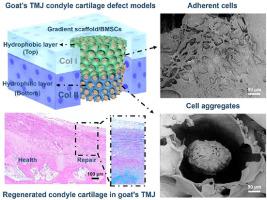Acta Biomaterialia ( IF 9.7 ) Pub Date : 2020-11-22 , DOI: 10.1016/j.actbio.2020.11.031 Xi Yu , Yihui Hu , Luxiang Zou , Shifeng Yan , Huimin Zhu , Kunxi Zhang , Wenguang Liu , Dongmei He , Jingbo Yin

|
Temporomandibular joint (TMJ) supports chewing, talking or other daily oral activities. So far, it still remains a great challenge to treat the defected TMJ condyle cartilage through tissue engineering technology. Herein, a bilayered scaffold is designed to fully reconstruct the different cartilage matrices of TMJ condyle under same induction condition. The bilayered scaffold with segregated hydrophobicity-hydrophilicity in top and bottom layer is prepared from a low and high content of polyethylene glycol (PEG) crosslinked poly (L-glutamic acid)-g-polycaprolactone (PLGA-g-PCL). The hydrophobic aggregates in top layer support the adhesion and spread of bone mesenchymal stem cells (BMSCs), thus inducing the differentation towards fibrocartilage; while aggregates (spheroids) are formed on the hydrophlic bottom layer, showing a preferable hyaline differentiation pathway under same chondrogenic induction in vitro. After 14 d in vitro induction, the scaffold/BMSCs construct is implanted in goat TMJ condyle defects. The post-operative outcome after 2 months demonstrates that the defects are fully covered by neo-cartilage. And the regenerated hierarchical TMJ condyle cartilage perfectly consist of ordered fibrocartilage and hyaline cartilage, which is same as natural condyle cartilage. These results corroborate that this bilayered scaffold with segregated hydrophilicity-hydrophobicity carrying induced BMSCs is a promising for treatment of TMJ condyle cartilage defects.
中文翻译:

具有隔离的亲水性-疏水性的双层支架能够重建山羊分级颞下颌关节con突软骨
颞下颌关节(TMJ)支持咀嚼,交谈或其他日常口腔活动。到目前为止,通过组织工程技术治疗缺损的TMJ dy突软骨仍然是一个巨大的挑战。在本文中,双层支架被设计为在相同诱导条件下完全重建TMJ con突的不同软骨基质。在顶部和底部的隔离层的疏水性-亲水性的双层支架由低和聚乙二醇的含量高(PEG)交联的聚(L-谷氨酸)制备-克-polycaprolactone(PLGA-克-PCL)。顶层的疏水性聚集体支持骨间充质干细胞(BMSCs)的粘附和扩散,从而诱导向纤维软骨的分化。聚集体(球状体)形成在亲水性底层上,在相同的体外成软骨诱导下显示出较好的透明途径。体外培养14天后诱导后,将支架/ BMSCs构建体植入山羊TMJ con突缺损中。2个月后的术后结果表明,新软骨完全覆盖了缺损。再生的分层TMJ con突软骨完全由有序的纤维软骨和透明软骨组成,与天然natural突软骨相同。这些结果证实了这种具有分离的亲水性-疏水性的诱导的BMSCs的双层支架对于治疗TMJ con突软骨缺损是有希望的。



























 京公网安备 11010802027423号
京公网安备 11010802027423号